What To Sell On Amazon: 7 Ways To Find Profitable Products

Not sure what to sell on Amazon? We’ve got you covered.
As the most popular ecommerce marketplace in the world, Amazon is a great place to open up shop. But if you want to make consistent sales and turn a profit, you’ll need to choose the right items to sell.
The goal is to find products with high margins, low competition, and plenty of demand.
And that’s precisely what we’re going to be helping you with in this post.
First, we’ll show you 7 ways to discover profitable products to sell on Amazon. Then, we’ll show you how to source products, and we’ll share some examples of trending products that are selling like hotcakes on Amazon right now.
And finally, we’ll wrap up with the answers to some of the FAQs that new Amazon sellers need to know.
7 ways to find profitable products
Below, we’ve shared 7 of our favorite methods for finding profitable products to sell on Amazon.
Note: Keep in mind that these are just ways to generate product ideas. You’ll need to crunch the numbers yourself in order to validate those ideas and determine whether or not a particular product could be profitable. For example, you’ll need to look at the average sale price of a given product, and then subtract your costs and selling fees from it to work out your profit margins.
1. Browse the Best Sellers list
Amazon’s Best Sellers list is the best place to start when you’re searching for products.
It shows you a ranking of the most popular products on the marketplace in different product categories, based on sales figures.
Start by opening up the web page, then select a department (niche/category). For example, if you want to sell health & beauty products, you might select the Beauty & Personal Care department.
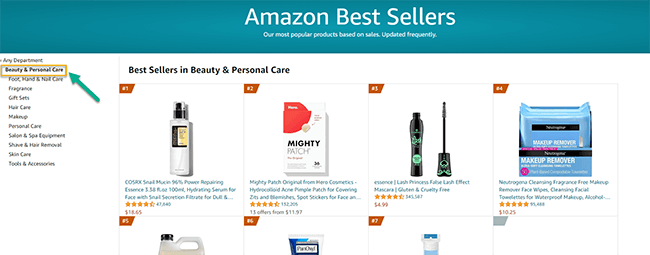
If you wanted, you could then select sub-categories within that department. For example, Skin Care > Face.
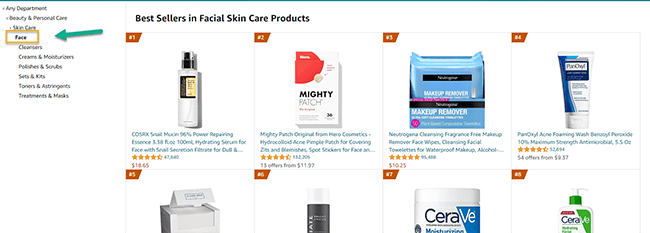
You’ll be able to see the 100 top selling items within that department/category, which can help you find products that are guaranteed to be in demand in your niche.
Obviously, the only downside to this method is that while products on the best sellers list are in high demand, they also tend to have lots of competition. You’ll need a strong listing with competitive prices and great SEO optimization to compete.
Bonus tip: You can also see if a given product is ranking on any best-seller lists from the product listing. Just scroll down to the product information section of the page and look at the BSR (Best Seller Rating).
2. Check out Movers & Shakers
At the top of the Best Sellers page, you should see a tab that says Movers and Shakers
Click this, and you’ll see a list that shows you the biggest gainers in sales rank over the last 24 hours within any product department or category.

This can be a really good way to spot trending items.
If something is featured on the Movers & Shakers list, there’s a good chance demand for that product is rising rapidly. If you move quickly, you can capitalize on that and make a ton of sales.
Bonus tip: If you’re focusing on trending products, make sure the rise in demand isn’t a ‘flash in the pan’ before you go all-in. Some products will trend upwards following a viral social media trend for a week, then suddenly plummet.
3. Use Product Opportunity Explorer
Product Opportunity Explorer is a free product research tool for Amazon sellers. It provides insights into what Amazon shoppers are searching for and purchasing.

You can access Product Opportunity Explorer through Seller Central once you’ve logged in to your Amazon seller account.
From there, you can explore detailed reports for trending products in any niche, with data such as:
- Search volume
- Average units sold
- Average price
- Number of sellers
- Seasonality
- Customer reviews & ratings
- Purchasing behavior
You can use these metrics to analyze opportunities and assess the competition and demand.
4. Use a third-party Amazon research tool
Aside from the Product Opportunity Explorer, there are also a bunch of other third-party tools that can help you find profitable products to sell on Amazon.
For example, the AMZScout Chrome extension surfaces data to help you analyze opportunities as you browse the marketplaces.

It can show you data on the number of sales, average sales prices, FBA fees, and the number of other sellers for each product in a niche.
Plus, it can also show you the net profit margin for that product, so you can easily pick out the most profitable items. And surface historical performance data, so you can see whether sales are trending up or down over time.
AMZScout is a paid platform but you can get some around 15 searches with their trial.
5. Look at what’s selling on other platforms
So far, we’ve looked at ways you can find profitable products by looking at what’s already being sold successfully on Amazon.
But another method is to look at what’s being sold on other online marketplaces/ecommerce platforms, like:
- Ebay
- Etsy
- Shein
- Temu
- AliExpress
If you find a product that’s sold thousands of units on one of these platforms, there’s a good chance it will sell really well on Amazon too.
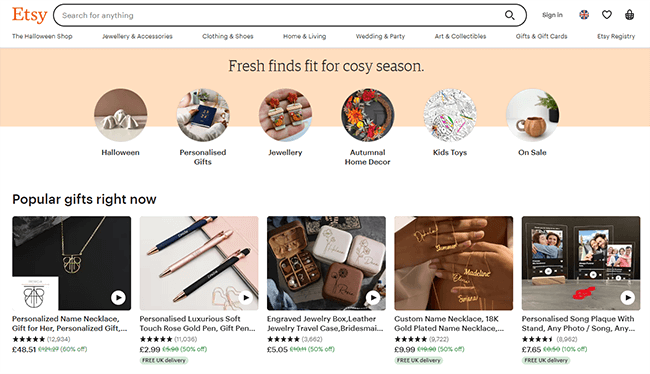
Even better, if that product isn’t listed for sale anywhere on Amazon, it could be a fantastic gap in the market for you to fill. Products with zero competition on Amazon but proven demand on other platforms are golden opportunities.
6. Conduct keyword research to find a gap in the market
Another way to find profitable products with low competition is to do careful keyword research.
One way to go about this is to use the autofill method.
Start by typing a broad product search query into Amazon, e.g. ‘wireless headphones’. Then, add a modifier word, e.g. ‘for’, ‘with’, or ‘without’:

You should see a bunch of pre-populated search suggestions full of long-string keywords. If something appears in these search suggestions, it’s a strong indicator that shoppers have searched for it before. In other words, it tells us there’s probably demand for it.
But because these long-string keywords tend to be for very specific products, there also tends to be low competition for them.
Try searching for different keywords that appear in the search suggestions after you use this method. Then, see if any other sellers have already created listings targeting those keywords.
If none have (or only a few have), this could be your gap in the market.
Bonus tip: There are tools out there that can help you to do keyword research more effectively. For example, some tools will show you the monthly search volume (a good metric to measure demand) and competition for each query. See our roundup of the best keyword research tools of the year.
7. Research the competition
Another easy way to find profitable products is to simply copy other successful sellers.
Start by choosing a niche, then look for the most successful Amazon sellers within that niche. These will usually be those rankings at the top of the page for popular products.
Click Visit the store to see what else they’re selling, and reverse engineer their strategy.
Don’t just make a carbon copy clone of their store, but look at which products they’re having the most success with and start there.
Bonus tip: Look at their customer reviews to see how you can differentiate your products/store to make them even better.
5 trending Amazon products to sell this year
The best way to figure out what to sell on Amazon is to use the methods above to research the market and find profitable products on your own.
However, in case that all seems like a lot of work, we’re also going to be sharing some specific recommendations of the best products to sell on Amazon this year. Here we go.
1. Alternative pet food
Pet food and pet supplies generally are great areas to focus on, as these product categories have a relatively low number of listings compared to their search volume, and profit margins are high.
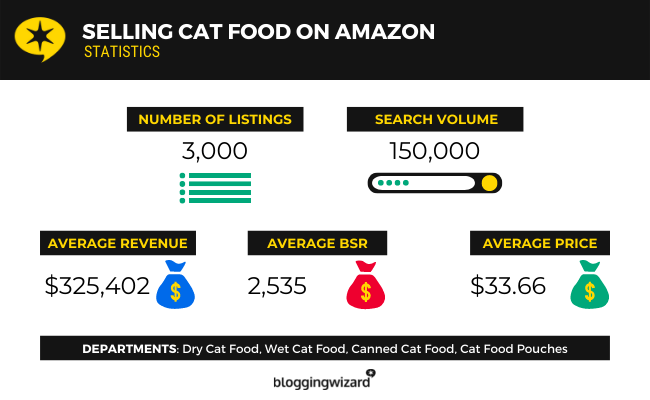
For example, ‘cat food’ has a monthly search volume of 150,000, but there were only 3,000 ‘cat food’ products listed on Amazon as of our latest analysis of the data, so there should be plenty of room for new sellers.
To differentiate yourself from the competition, it might be worth focusing on new kinds of ‘alternative’ pet foods that appeal to the growing niche market segment of health-conscious pet owners.
For example, searches for ‘raw dog food’ have been trending upwards, per Google Trends data.
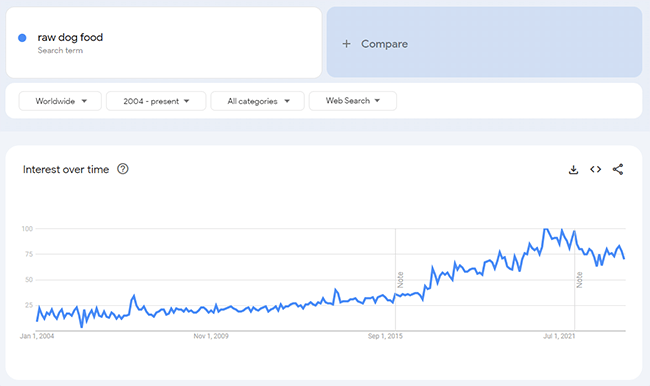
Likewise, searches for ‘vegan dog food’ are up considerably compared to a decade ago.
2. Wireless chargers
Wireless chargers are another great product for new Amazon sellers to sell.
They’re high in demand right now, with a monthly search volume of over 200,000. And there’s still a relatively low number of listings to compete with (around 1,000 at the time of our latest analysis).
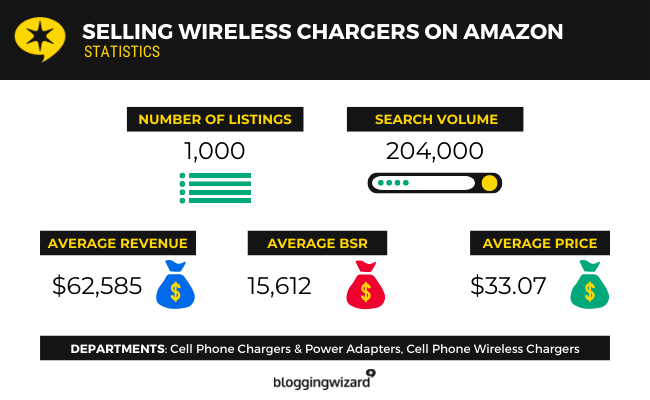
Plus, wireless chargers should be relatively easy to source. You should be able to get them for less than a dollar a piece if you buy in bulk from wholesalers on sites like Alibaba. And the average sale price on Amazon is $33.07, so profit margins are fantastic.
3. Bluetooth speakers
This is another product in the tech category that’s always in demand, with a monthly search volume of over 330,000.
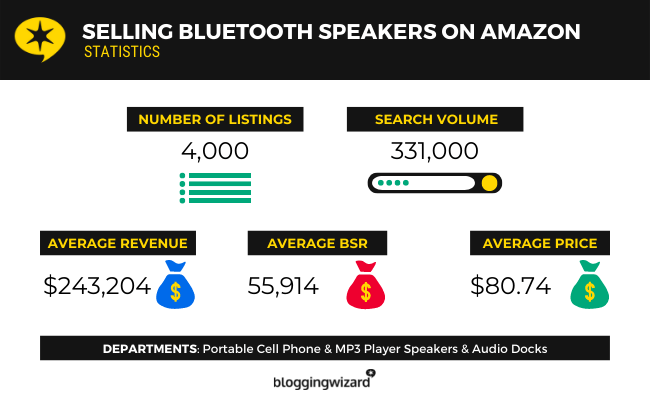
There are over 4,000 listings on Amazon for Bluetooth speakers, which isn’t too competitive. And you can help differentiate yourself from the competition by focusing on a specific section of the market.
For example, you might focus specifically on waterproof, portable, or outdoor Bluetooth speakers.
The average annual revenue that each Amazon listing for a Bluetooth speaker earns is around $243,000.
4. Korean skincare
Beauty & skincare products are some of the best products to sell on Amazon as they offer decent margins and are in high demand, but because the space is competitive, it helps to niche down.
As such, you might want to focus on ‘Korean skincare’. If we look at the Google trends data, it’s clear this is a segment of the market that’s really taking off.
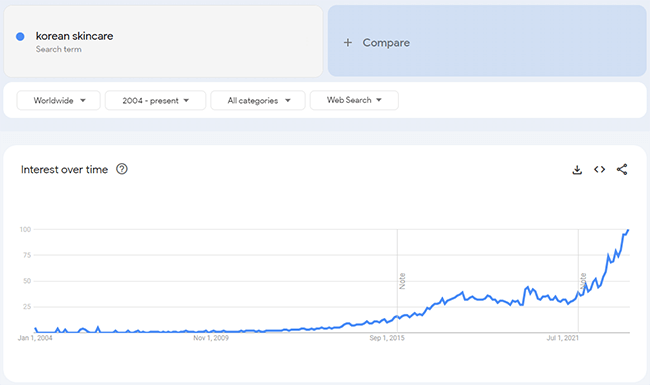
Monthly searches have been trending upwards sharply over the last couple of years as Western consumers become increasingly interested in Korean culture, making now the perfect time to sell Korean skincare products before it gets too competitive.
5. Scented candles
There are tons of scented candles on Etsy. But on Amazon, there isn’t as much competition as you might think.
There were around 10k listings as of our latest analysis, and the average revenue of each listing was over $52,000—that’s huge.
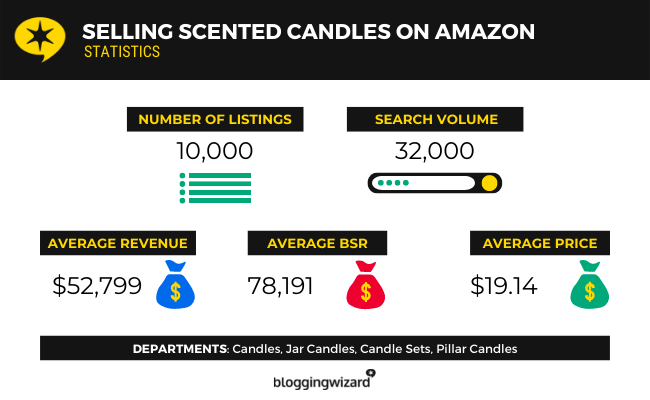
Plus, it’s fairly easy to start selling scented candles as they’re relatively inexpensive to buy and widely available from suppliers. You could even make your own if you were so inclined.
Again, it’ll help to niche down and focus on a specific type of scented candle. For example, wood-wick candles, or candles made with soy wax.
How to source products to sell on Amazon
So you’ve found some products you want to sell on Amazon—but how do you actually get them?
Well, you have a few different options. Let’s take a look at each of them
Dropshipping
One way to source products to sell on Amazon is to work with a dropshipping supplier.
With dropshipping, you don’t have to buy any stock upfront, and you don’t have to worry about shipping/fulfillment.
All you have to do is pick the products you want to sell and add them to your Amazon store. When a customer places an order with you, you place the order with your dropshipping supplier and enter the customer’s details for fulfillment. Your supplier ships the product directly to the customer for you.
The great thing about this method is it’s super easy to get started with, and almost completely risk-free as you don’t pay for anything until your customer has already paid you.
To get started, you’ll need to sign up for a dropshipping platform. We’d recommend Spocket—it gives you access to thousands of products from dropshipping suppliers in the EU and US.
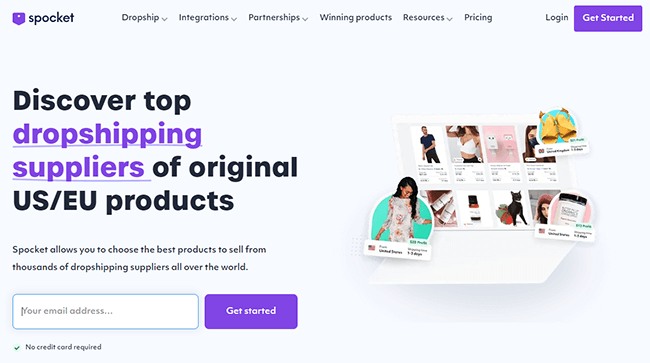
Then, you can import products to your Amazon store and start selling. If you’d rather source products for dropshipping manually, you can browse AliExpress for tens of thousands of products suitable for dropshipping from suppliers in China.
Print on demand
Print on demand is another risk-free way of sourcing products without having to purchase any stock upfront, much like dropshipping.
There are lots of print on demand sites that provide a catalog of blank, white-label products for sellers to customize. You can upload your own original designs to these products to create custom merchandise, then sell that merch through your Amazon store.
When you make a sale, the order gets sent through to the print on demand site. They produce the order and ship it straight to the customer, and you only pay for what you sell.
We’d recommend using Gelato as it has a huge catalog of print on demand products for you to choose from including apparel, phone cases, wall art, mugs, phone cases, and more.

Note: Gelato doesn’t offer direct Amazon integration, but it’s possible to send the orders you receive on your Amazon store to Gelato via Shopify.
Wholesale
Another way to get products to sell on Amazon is to buy them from wholesalers.
This tends to offer better margins than dropshipping but it’s also more hands-on. So, you’ll have to handle inventory management and order fulfillment yourself.
You can find wholesale suppliers on sites like Alibaba. You’ll usually need to buy their products in bulk to access wholesale prices, as most wholesale suppliers have minimum order quantities.

Obviously, you’ll also need somewhere to store your inventory. If you don’t have a warehouse space of your own, you can use Amazon’s FBA (fulfilled by Amazon) service.
With FBA, you source the products from suppliers but Amazon stores them for you and handles shipping, customer service, and returns.
You’ll need to factor in the cost of FBA when determining your selling price.
Private label
Another way to source products is to work with a private-label manufacturer.
With private label manufacturing, you outsource the production of the products you sell to a third-party manufacturer but sell them under your own brand. It’s a little like print on demand but you have more control over your supply chain and the production process.
Depending on the manufacturer you work with, you may be able to direct them in terms of things like the materials and ingredients used, the size, color, and length, the production rate, etc.
You’ll also have full control over things like packaging and branding.
To find a private label manufacturer, you can look in your local area, speak to other retailers that stock similar products to find out who they work with, or search online.
Bonus tip: Depending on how much money you have available to invest, you might even want to work with a private-label manufacturer to produce a completely new product of your invention. Check out our guide on how to come up with new product ideas for advice on getting started.
Retail arbitrage
With retail arbitrage, you buy products from other retailers (rather than suppliers) and then resell them on Amazon at a markup for a profit.
An example might be buying a $10 product from Walmart and then listing it for sale at $40 on your Amazon store.
If you want to go down the retail arbitrage route, some good places to source products include flea markets, garage sales, off-price stores (i.e. T.J. Maxx), charity shops, etc.
DIY ecommerce
One final way to get products to sell on Amazon is to make them yourself from scratch.
This is perfect for products that can be hand-made, like soaps, candles, bath bombs, jewelry, etc. But obviously, it’s not going to be suitable for products that require a more complex manufacturing process.
To explore your options, check out our roundup of the 27 best things to make and sell online.
Frequently asked questions
How much do Amazon sellers make?
According to a recent survey, the large majority of Amazon sellers make at least $1,000 per month in online sales. What’s more, the top 26% of sellers make over $25,000 per month in sales.
Can you sell stuff directly to Amazon?
Wholesalers can sell directly to Amazon through the Amazon Vendor Central program. However, it’s invite-only, so you’d have to have an existing relationship with Amazon in order to become a first-party seller.
Other than that, regular merchants can sell their products on Amazon, but not directly to Amazon.
What percent does Amazon take from sellers?
It depends on the category of the product sold. Amazon can charge anywhere from 8% to 45% of each sale in referral fees, depending on the product category (but often, it’ll be around 15%). In addition, there may be other fees such as listing fees, closing fees, etc.
If you’d rather not have to deal with Amazon’s referral fees, and you want to keep all of your profit for yourself, it might be a better idea to start selling products through your own online store instead.
You’ll need an ecommerce platform to build your store and start selling online. Check out our roundup of the 11 best ecommerce platforms to explore your options. Then, take a look at our data-driven roundup of the best products to sell online for ideas on what to sell through it.
Final thoughts
That concludes our in-depth guide to what to sell on Amazon.
Hopefully, you now know how to find profitable products to sell online, and how to source them.
Just remember: It’s not all about what you sell. The success of your store will also largely depend on things like your pricing, positioning, marketing strategy, SEO, etc.
Want to learn more about what it takes to be a successful online seller? Check out our roundup of the 32 most important ecommerce statistics.
Disclosure: Our content is reader-supported. If you click on certain links we may make a commission.
